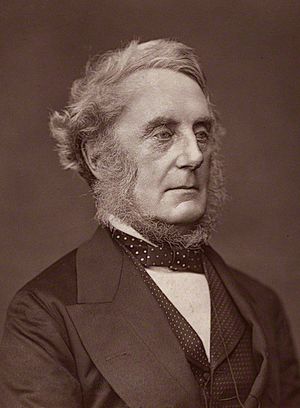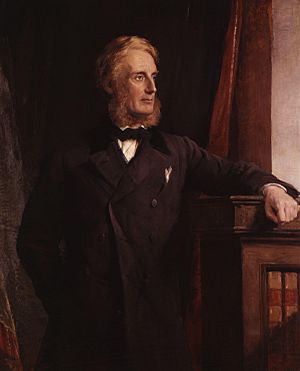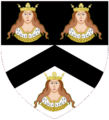Edward Cardwell, 1st Viscount Cardwell facts for kids
Quick facts for kids
The Viscount Cardwell
|
|
|---|---|

The 1st Viscount Cardwell, c. 1878
|
|
| Secretary of State for War | |
| In office 9 December 1868 – 17 February 1874 |
|
| Monarch | Victoria |
| Prime Minister | William Ewart Gladstone |
| Preceded by | Sir John Pakington, Bt |
| Succeeded by | Hon. Frederick Stanley |
| Secretary of State for the Colonies | |
| In office 7 April 1864 – 26 June 1866 |
|
| Monarch | Victoria |
| Prime Minister | The Viscount Palmerston The Earl Russell |
| Preceded by | The Duke of Newcastle |
| Succeeded by | The Earl of Carnarvon |
| Chancellor of the Duchy of Lancaster | |
| In office 25 July 1861 – 7 April 1864 |
|
| Monarch | Victoria |
| Prime Minister | The Viscount Palmerston |
| Preceded by | Sir George Grey, Bt |
| Succeeded by | The Earl of Clarendon |
| President of the Board of Trade | |
| In office 28 December 1852 – 31 March 1855 |
|
| Monarch | Victoria |
| Prime Minister | The Earl of Aberdeen The Viscount Palmerston |
| Preceded by | J. W. Henley |
| Succeeded by | The Lord Stanley of Alderley |
| Personal details | |
| Born | 24 July 1813 |
| Died | 15 February 1886 (aged 72) Torquay, Devon |
| Nationality | British |
| Political party | Tory Peelite Liberal |
| Spouse | Annie Parker (d. 1887) |
| Alma mater | Balliol College, Oxford |
Edward Cardwell, 1st Viscount Cardwell (born July 24, 1813 – died February 15, 1886) was an important British politician in the 1800s. He was part of the Peelite and Liberal parties.
Cardwell is best known for his time as Secretary of State for War from 1868 to 1874. During this period, he introduced major changes to the British Army. These changes, known as the Cardwell Reforms, aimed to make the army more modern and efficient.
Contents
Early Life and Education
Edward Cardwell was born in Liverpool. His father, John Henry Cardwell, was a merchant. Edward went to Winchester College and then to Balliol College, Oxford. He finished his degree in 1835. In 1838, he became a lawyer.
Edward Cardwell's Political Journey
Cardwell started his career working for the Colonial Office in the late 1830s. He helped write important instructions for how to deal with the Maori people in New Zealand.
Starting in Government
He became a close supporter of Sir Robert Peel, who was the Prime Minister. Cardwell got his first government job as the Financial Secretary to the Treasury from 1845 to 1846.
In 1846, the Conservative Party split over a law about food prices called the Corn Laws. Cardwell stayed loyal to Peel and joined the "Peelite" group. When the Peelites came to power in 1852, Cardwell became the President of the Board of Trade. He held this job until 1855.
In 1854, he helped pass a law called the Railway and Canal Traffic Act 1854. This law helped stop railway companies from competing too fiercely, which was bad for both the companies and their customers.
Moving Between Roles
Cardwell served in Parliament for different areas. He was elected for Liverpool in 1847. Later, he won a seat for Oxford in 1852.
The Peelite group broke up in the late 1850s. In 1859, Cardwell officially joined the Liberal Party. He then became the Chief Secretary for Ireland. Two years later, he moved to another role as Chancellor of the Duchy of Lancaster. In 1864, he became the Secretary of State for the Colonies. He stayed in this position until 1866.
Leading the War Office
Cardwell reached the most important part of his career when the Liberals returned to power in 1868. He became Secretary of State for War under Prime Minister William Ewart Gladstone.
During his six years in this role, Cardwell made big changes to the British army. These changes are known as the "Cardwell reforms". He made the army more professional. He also changed how officers were promoted, making it based on skill instead of how much money they had. He also created a reserve force in Britain.
The Cardwell Reforms: Modernizing the Army
Prime Minister William Ewart Gladstone wanted the army to be more efficient. He supported Cardwell's plans for big changes in 1870. A major reason for these reforms was that Germany's army had shown how strong a professional, well-equipped army could be.
Key Goals of the Reforms
The main goals of the Cardwell Reforms were:
- To give the War Office more control over the army.
- To stop officers from buying their positions and promotions.
- To create a strong reserve force in Britain. This was done by having shorter service terms for soldiers.
Cardwell worked to improve the lives of soldiers. In 1868, he stopped the practice of flogging (whipping) soldiers. This helped make being a soldier a more respected job. He also stopped giving "bounty money" to new recruits.
He also brought 20,000 soldiers back from colonies like Canada. This meant the colonies had to start taking more responsibility for their own defense.
Ending the Purchase System
The most significant change was ending the system where officers could buy their commissions and promotions. Before this, rich families controlled the higher ranks in the army. Promotion depended on a family's wealth, not an officer's talent. This meant that many skilled people from middle-class families could not become officers.
British officers were expected to be gentlemen, not necessarily military experts. Some people worried that professional officers might become too powerful. However, the rise of countries like Germany showed that an inefficient army was too risky.
The plan to end the purchase system included paying back the money current officers had spent. This plan passed in the House of Commons in 1871. However, the House of Lords tried to block it. Gladstone then used his power to force the Lords to approve the original plan.
A famous example used to show why the system needed to change was Lord Cardigan. He spent a lot of money to buy his position. He then led the disastrous "Charge of the Light Brigade" during the Battle of Balaklava in 1854. This showed that buying positions did not lead to good leaders.
Changes to Army Structure
Cardwell also reorganized the War Department. He made the Secretary of State for War more powerful than the Army's Commander-in-Chief. At the time, the Commander-in-Chief was The Duke of Cambridge, who was the Queen's cousin and against the reforms.
The militia (a local defense force) was also reformed and became part of the regular army. The time soldiers had to serve was shortened to six years. This created more turnover and a larger group of trained reserve soldiers.
Cardwell managed to reduce the army's budget. At the same time, he increased the army's strength. He added 25 battalions, 156 field guns, and many supplies. The number of reserve soldiers available for foreign service grew from 3,500 to 36,000 men.
Personal Life
Lord Cardwell married Annie Parker in 1838. They did not have any children.
He passed away in Torquay, Devon, in February 1886, at the age of 72. He was buried in Highgate Cemetery in London. Lady Cardwell died the following year, in February 1887.
The town of Cardwell in Queensland, Australia, was named after Lord Cardwell.
Images for kids






